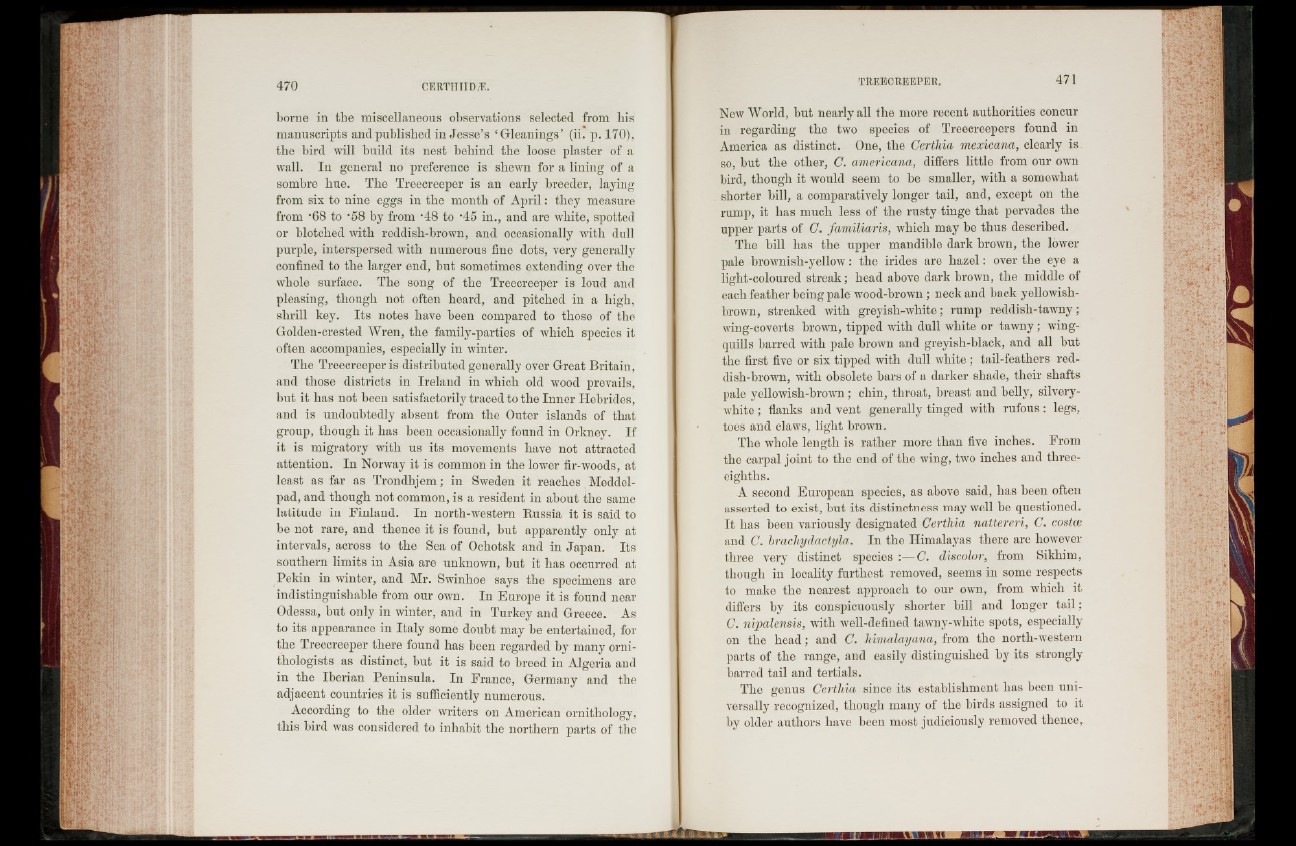
borne in the miscellaneous observations selected from his
manuscripts and published in Jesse’s ‘Gleanings’ (ii. p. 170),
the bird will build its nest behind the loose plaster of a
wall. In general no preference is shewn for a lining of a
sombre hue. The Treecreeper is an early breeder, laying
from six to nine eggs in the month of A pril: they measure
from -68 to *58 by from ‘48 to -45 in., and are white, spotted
or blotched with reddish-brown, and occasionally with dull
purple, interspersed with numerous fine dots, very generally
confined to the larger end, but sometimes extending over the
whole surface. The song of the Treecreeper is loud and
pleasing, though not often heard, and pitched in a high,
shrill key. Its notes have been compared to those of the
Golden-crested Wren, the family-parties of which species it
often accompanies, especially in winter.
The Treecreeper is distributed generally over Great Britain,
and those districts in Ireland in which old wood prevails,
but it has not been satisfactorily traced to the Inner Hebrides,
and is undoubtedly absent from the Outer islands of that
group, though it has been occasionally found in Orkney. If
it is migratory with us its movements have not attracted
attention. In Norway it is common in the lower fir-woods, at
least as far as Trondhjem; in Sweden it reaches Meddel-
pad, and though not common, is a resident in about the same
latitude in Finland. In north-western Russia it is said to
be not rare, and thence it is found, but apparently only at
intervals, across to the Sea of Ochotsk and in Japan. Its
southern limits in Asia are unknown, hut it has occurred at
Pekin in winter, and Mr. Swinhoe says the specimens are
indistinguishable from our own. In Europe it is found near
Odessa, but only in winter, and in Turkey and Greece. As
to its appearance in Italy some doubt may be entertained, for
the Treecreeper there found has been regarded by many ornithologists
as distinct, but it is said to breed in Algeria and
in the Iberian Peninsula. In France, Germany and the
adjacent countries it is sufficiently numerous.
According to the older writers on American ornithology,
this bird was considered to inhabit the northern parts of the
New World, but nearly all the more recent authorities concur
in regarding the two species of Treecreepers found in
America as distinct. One, the Certliia mexicana, clearly is.
so, but the other, C. americana, differs little from our own
bird, though it would seem to be smaller, with a somewhat
shorter bill, a comparatively longer tail, and, except on the
rump, it has much less of the rusty tinge that pervades the
upper parts of G. familiaris, which may be thus described.
The bill has the upper mandible dark brown, the lower
pale brownish-yellow: the irides are h azel: over the eye a
light-coloured streak; head above dark brown, the middle of
each feather being pale wood-brown ; neck and back yellowish-
brown, streaked with greyish-white; rump reddish-tawny;
wing-coverts brown, tipped with dull white or tawny; wing-
quills barred with pale brown and greyish-black, and all but
the first five or six tipped with dull white ; tail-feathers reddish
brown, with obsolete bars of a darker shade, their shafts
pale yellowish-brown; chin, throat, breast and belly, silvery-
white ; flanks and vent generally tinged with rufous : legs,
toes and claws, light brown.
The whole length is rather more than five inches. From
the carpal joint to the end of the wing, two inches and three-
eighths.
A second European species, as above said, has been often
asserted to exist, but its distinctness may well be questioned.
It has been variously designated Certliia nattereri, C. costce
and C. brachydactyla. In the Himalayas there are however
three very distinct spiecies :—C. discolor, from Sikhim,
though in locality furthest removed, seems in some respects
to make the nearest approach to our own, from which it
differs by its conspicuously shorter bill and longer ta il;
C. nipalensis, with well-defined tawny-white spots, especially
on the head; and C. liimalayana, from the north-western
parts of the range, and easily distinguished by its strongly
barred tail and tertials.
The genus Certliia since its establishment has been universally
recognized, though many of the birds assigned to it
by older authors have been most judiciously removed thence,